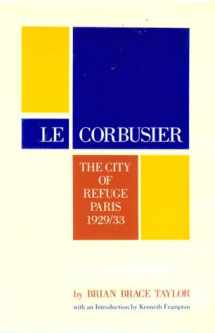
Le Corbusier: The City of Refuge, Paris 1929/33
ISBN-13:
9780226791340
ISBN-10:
0226791343
Edition:
1
Author:
Brian Brace Taylor
Publication date:
1987
Publisher:
University of Chicago Press
Format:
Hardcover
200 pages
Category:
Buildings
,
Architecture
,
United States History
,
France
,
European History
FREE US shipping
Book details
ISBN-13:
9780226791340
ISBN-10:
0226791343
Edition:
1
Author:
Brian Brace Taylor
Publication date:
1987
Publisher:
University of Chicago Press
Format:
Hardcover
200 pages
Category:
Buildings
,
Architecture
,
United States History
,
France
,
European History
Summary
Le Corbusier: The City of Refuge, Paris 1929/33 (ISBN-13: 9780226791340 and ISBN-10: 0226791343), written by authors
Brian Brace Taylor, was published by University of Chicago Press in 1987.
With an overall rating of 3.5 stars, it's a notable title among other
Buildings
(Architecture, United States History, France, European History) books. You can easily purchase or rent Le Corbusier: The City of Refuge, Paris 1929/33 (Hardcover) from BooksRun,
along with many other new and used
Buildings
books
and textbooks.
And, if you're looking to sell your copy, our current buyback offer is $0.3.
Description
The City of Refuge complex—commissioned by the Salvation Army as part of its program to transform social outcasts into spiritually renewed workers—represents a significant confluence of design principles, technological experiments, and attitudes on reform. It also provides rare insights into the work of one of the twentieth century's greatest architects, Le Corbusier. Brian Brace Taylor draws on extensive archival research to reconstruct each step of the architect's attraction to the commission, his design process and technological innovations, the social and philosophical compatibility of the Salvation Army with Le Corbusier's own ideas for urban planning, and finally, the many modifications required, first to eliminate defects and later to accommodate changes in the services the building provided. Throughout, Taylor focuses on Le Corbusier's environmental, technological, and social intentions as opposed to his strictly formal intentions. He shows that the City of Refuge became primarily a laboratory for the architect's own research and not simply a conventional solution to residents' requirements or the Salvation Army's program.


We would LOVE it if you could help us and other readers by reviewing the book
Book review

Congratulations! We have received your book review.
{user}
{createdAt}
by {truncated_author}


